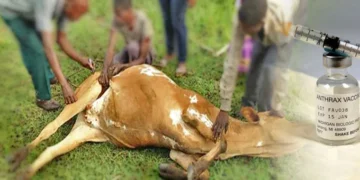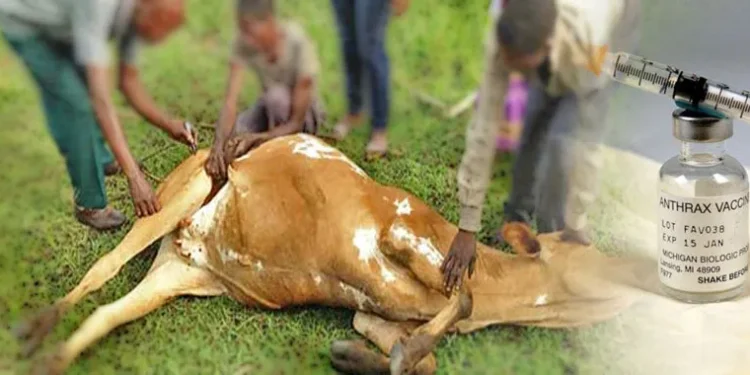A great number of Nigerians have developed a sense of unease as a result of the identification of the country’s first confirmed case of anthrax sickness.
The illness known as anthrax is a serious condition that may manifest itself in either people or animals.
On Monday, July 17, the Federal Ministry of Agriculture and Rural Development (FMARD) issued a statement saying that the Office of the Chief Veterinary officer of Nigeria was alerted of animals on a farm in Suleja, Niger State, that were exhibiting signs of a suspected case of an infectious illness. The ailment in question is thought to be contagious.
Cattle, sheep, and goats were some of the animals that were kept on the farm, which was referred to as a “multi-species animal farm.”
Anthrax has been linked to both hides (known as “Ponmo”) and bush foods, both of which are considered to be Nigerian culinary specialties.
However, the Nigeria Centre for Disease Control and Prevention (NCDC) has promised that the Federal Government has put certain preventative measures in place to protect the safety of Nigerians. This was stated by the NCDC in a statement. However, the Center also cautioned Nigerians to avoid contact with any agents that might spread the sickness.
What is Anthrax?
According to the National Center for illness Control and Prevention (NCDC), anthrax is a serious illness that is brought on by the bacterium bacillus anthracis. It is possible for it to have an effect on both people and animals, including wild animals as well as domesticated animals such as cows, pigs, camels, sheep, goats, and so on. Spores of the bacteria may be discovered in the soil, the wool, or the hair of animals that have been affected with the disease.
The National Center for illness manage and Prevention (NCDC) reports that anthrax spores are resistant to harsh circumstances and may live in the soil or environment for decades, which makes it exceedingly difficult to manage or eradicate the illness.
Also, the Centers for illness Control and Prevention (CDC) said that anthrax is a deadly infectious illness that is caused by gram-positive, rod-shaped bacteria known as Bacillus anthracis. This bacterium exists naturally in soil and regularly affects domestic animals as well as wild animals all over the globe.
According to the Center for Disease Control and Prevention (CDC), anthrax is not infectious; nonetheless, it may cause illness in humans if they come into contact with infected animals or goods derived from animals.
This indicates that the disease cannot be passed on from one person to another, with the exception of cutaneous anthrax, in which there is a remote possibility of direct infection from the lesions that are present on the body of another individual.
According to the World Health Organization (WHO), inhalation anthrax cannot be passed from one person to another and can only be caught by directly breathing anthrax spores. This is the only way the disease may be spread.

How humans get infected
People who work in environments where they come into close touch with sick animals or animal-related products, such as wool, skins, or hair, are responsible for the vast majority of anthrax infections. There are a number of ways a person might be exposed to anthrax and develop the illness.
The following is a list of possible routes via which persons might get anthrax:
Taking in spores via the lungs.
Consuming food or water that has been polluted with spores and then becoming sick as a result.
Consuming meat from contaminated animals that has been eaten raw or undercooked.
acquiring spores via a skin wound or abrasion on the body.
The following is a list of the ways that people might get infected with anthrax according to the NCDC:
Infection of the skin, often known as direct contact with infectious animals via cuts or lesions in the skin
gastrointestinal, specifically by the consumption of raw or partially cooked meat from contaminated animals or any products derived from such animals, including milk.
Inhalation, also known as taking in the spores via the lungs, is the most lethal form of the illness.
Possible symptoms
The signs and symptoms of anthrax may vary widely depending on the kind of exposure and how it was received. It is also essential to keep in mind that the sickness is very uncommon, and that its symptoms might be confused with those of other diseases or illnesses. If one is experiencing any symptoms that are cause for worry, however, it is very necessary to seek medical treatment.
Anthrax may give people a fever, painless skin lesions with a black center that occur after the blisters, overall body weakness, and difficulties breathing, according to the National Center for Disease Control and Prevention (NCDC). Additionally, it has the potential to produce a serious digestive ailment that is quite similar to food poisoning.
High fever, weakness, lack of appetite, bleeding from all bodily openings (nose, mouth, ears, anus, etc.), swelling, trouble breathing, and bloody diarrhoea are some of the symptoms that animals experience when they are infected with the disease. In the majority of situations, it may result in an unexpected death.
At the time of slaughter, the blood of an animal infected with anthrax does not clot. Additionally, noticeable swelling and rapid deterioration may be seen just before to slaughter.
Persons at risk of contracting anthrax
The following categories of people have been recognized as being at an increased risk of developing the illness by the Nigerian Center for illness Control and Prevention and the Federal Ministry of Agriculture and Rural Development in Nigeria:
those who deal directly with animals, such as veterinarians, employees in veterinary labs, farmers, slaughterhouse workers, butchers, cattle rearers, livestock producers and merchants, wildlife handlers, hunters, park rangers, those who process, import, and export hides and skins, animal health workers, and others.
People who eat dead animals (cattle, sheep, or goats), such as those that have been discovered.
Healthcare personnel, employees in diagnostic laboratories, and caregivers who come into contact with patients or biological specimens of patients are said to be exposed.
Officers of the law include police, military, immigration, customs, and those working at points of entry, among others.
Anyone traveling to a place within or outside of Nigeria that has a confirmed anthrax case should take precautions.
Prevention
Vaccination against anthrax is one of the most effective strategies to avoid infection, and it is recommended for persons who are at a high risk of exposure to the disease. This includes laboratory professionals, livestock workers, and veterinarians. However, it is not known for definite whether or not the anthrax vaccination may be obtained in Nigeria.
In order to lessen the likelihood of the illness spreading further, the federal government has announced that it will start vaccinating animals throughout the country very soon.
In the meanwhile, the Nigerian Center for illness Control and Prevention (NCDC) recommends that Nigerians thoroughly inspect the livestock they eat and exercise extreme caution when purchasing animals such as cows, camels, sheep, and goats from Nigerian states that border Benin, Chad, the Niger Republic, Ghana, and Togo through waterways. This will help prevent the illness from spreading further.
As was previously stated, Nigerians should avoid eating skins (Ponmo), smoked meat and other byproducts of bush foods. Furthermore, they should exercise extreme care before ingesting ill or deceased animals. The NCDC also cautioned hunters against taking ill or dead animals from the wild for the purpose of eating by humans.
When working with ill animals, livestock owners should always wear their personal protective equipment and be careful to vaccinate their animals against anthrax, since this is the most effective preventative step against the disease. Vaccination of livestock is particularly important.
It is also considered that implementing proper hygienic procedures on the farm, such as routinely cleaning and disinfecting animal housing, feeding equipment, and water troughs, may help to lower the risk.
The Center also encouraged animal health professionals/handlers and healthcare workers to maintain infection prevention and control procedures, a high index of suspicion/vigilance, and to alert the health authorities (both human and animal) when they notice any person or animal with the symptoms. These recommendations were made in light of the fact that the Center for Disease Control and Prevention (CDC) is responsible for overseeing the outbreak.

Can Anthrax be treated?
Yes. Antibiotics are recommended as a course of treatment for the illness by both the WHO and the CDC.
“Hospitalization is necessary for all instances of anthrax that occur in humans. Prophylactic therapy may be given to those who are at risk of being exposed to anthrax spores. Antibiotics, which must be administered by a doctor or other qualified medical practitioner, are effective against anthrax. Always be sure you take the antibiotics exactly as your doctor tells you to. Carefully adhere to the directions, and under no circumstances should you attempt to speed up the treatment process. In the event that any unwanted consequences result from the therapy, it is imperative that you seek immediate medical attention. According to the World Health Organization (WHO), “No one should attempt to use antibiotics or any other drugs to treat or protect themselves without first consulting a qualified medical professional.”
Utilizing antitoxins, as directed by a medical professional, is still another approach that may be used in the treatment of anthrax. Antitoxins are designed to combat the effects of anthrax toxins in the body. Antitoxins are required to be used in conjunction with other treatment modalities by medical professionals. The Centers for Disease Control and Prevention (CDC) said that there are now a few different kinds of antitoxins that may be used to treat anthrax.




































